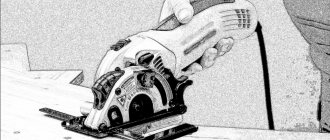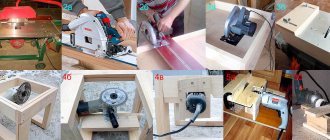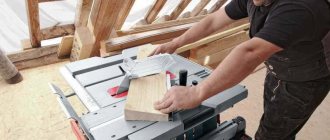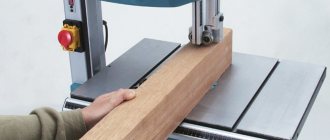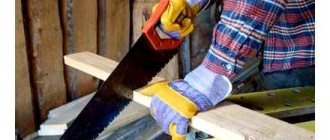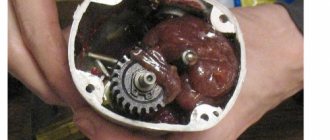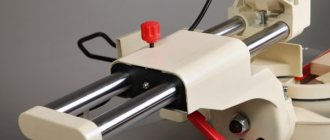Hello dear readers and subscribers of Andrey Noak’s blog. In this article I will tell you the difference between a plunge-cut saw and a circular saw.
The first thing that will catch your eye upon inspection is the location of the saw blade. The plunge-cut circular saw is equipped with a disk that is located above the sole and protected by a casing. It can also be noted that the cutting disc is located with a minimum distance from the edge with a spring-loaded “head”. This model is equipped with adjustment of cutting depth and angle. Expensive models have a soft start device and the ability to change the speed.
As for the principle of working with this tool, it’s all simple. Before starting work, set the depth of cut and the angle of inclination if necessary. And only after completing these operations can you begin to work. We plug it into the network, unlock the “head”, the disk is immersed into the workpiece to a given depth, then we guide the saw along the given trajectory. After making the cut, we release the hand pressure on the tool and the “head” rises due to the spring, thereby removing the saw blade from the material being processed. A good plus is the operation of a plunge-cut circular saw with a tire.
This design will help us achieve maximum sawing accuracy when working on the tool.
The rear sights can be noted. They are needed to determine the position of the disk and the cutting edge, that is, it is possible to determine the boundaries at which the cutting element must be immersed and promptly removed from the material being processed. The tags can be divided into two sets, in which you can work with or without a tire. In addition, eccentrics can be distinguished. They are able to adjust the edge of the bar and the parallelism of the cutting blade.
Plunge-cut circular saws with a guide bar are capable of smoothly cutting edges and jointing workpieces. These operations certainly cannot be performed using the stop of an ordinary circular saw. You can highlight the moment at which the cut can be made almost close to the wall.
The cleanliness of the workplace is achieved by a protective cover; it covers the cutting disc, thereby increasing the percentage of efficiency during the operation of vacuum cleaners.
The final conclusion is that this type of saw becomes an indispensable assistant in the workshop and is able to make work quick and convenient for you.
Some of the popular saws include:
- elitech pd1255p14;
- sp6000set.
These are what we will look at today.
Features and selection of plunge-cut saws
When processing wood using power tools, the problem of accurate cutting often arises. Unfortunately, even modern disk models cannot boast of a perfectly executed job. This is due to the impossibility of proper control over the position of the cutting tool relative to the workpiece. To solve the problem of sawing accuracy, a plunge-cut circular saw was invented and put into production, which immediately gained popularity among woodworking craftsmen and became a sales leader.
The best plunge-cut saw in terms of price-performance ratio
To be honest, among the cheapest models of plunge-cut saws for cutting laminated chipboards, it is almost impossible to choose a favorite. All models in the budget segment have many disadvantages. That is why we chose an affordable saw in the mid-price segment, which has an optimal price-quality ratio. Such a saw with the perfect balance of cost and quality was: BOSCH GKT 55 GCE. This particular model is in the highest demand among novice furniture makers and has good characteristics at a fairly affordable price.
Reviews
Owners of Festul brand saws value this tool for its accuracy, reliability, ease of setup, versatility and durability. Experienced craftsmen noted the ability of many models to quickly adapt during the process of servicing products of different formats, which is influenced by regulatory equipment. In addition, the manufacturer has introduced modern technological innovations, such as, for example, a dust removal system, which is very useful when working with drywall or wood.
The main disadvantage that such a plunge-cut saw with a guide bar has is the price. Thus, a model with average characteristics can be purchased for an average of 35-40 thousand rubles, which is quite expensive by the standards of the segment.
Also, owners of some models note minor ergonomic miscalculations. For example, many people note that this brand of plunge-cut saw does not have an effective noise reduction system. The sound of the engine and cutting requires the use of headphones.
As a rule, the majority of users have practically no complaints about the working functions.
Advantages and disadvantages of operation
Working with a plunge-cut saw
The scope of plunge-cut saws is wide - from the continuous production of wooden products and furniture to work in a home workshop. However, to analyze the relevance of purchasing such equipment, its positive and negative aspects of operation should be identified.
The main advantage of this hand-held woodworking tool is its versatility. With its help, you can make precise cuts to form blanks, trim the edges of furniture panels made of fiberboard or chipboard. If you have additional components, it becomes possible to create a shaped cut.
List of the main advantages of using plunge-cut saws for wood:
Let's sum it up
A circular saw is not as specialized a tool as it seems at first glance. If you need to work with more than just wood, you can choose a circular saw for wood, and then purchase replacement blades for cutting plastic or sheet aluminum.
In conclusion, let us remind you once again: any tool should be chosen based on the tasks that you intend to solve with its help. Fast and pleasant work will mean that the right choice has been made.
It is not enough to purchase a reliable circular saw. Without good equipment, she will not be able to cope with the assigned tasks. Only the installation of high-quality saw blades will allow you to achieve high productivity when working on wood.
Tool selection options
Pipe for connecting the exhaust system
Finding the best plunge saw model can be challenging. This is due to the large assortment and different indicators for each type of tool as a whole. Therefore, during selection, technical and operational characteristics should be comprehensively considered. Additionally, work safety requirements are taken into account.
One of the determining parameters of choice is the ease of use of hand tools. Therefore, before purchasing, it is recommended to hold the plunge-cut saw in your hands and, if possible, make several test cuts. This will help determine the degree of operating comfort and will allow you to form an initial opinion already at the stage of analyzing the models.
Description of technical characteristics
Plunge saw with tilt mechanism
After determining the feasibility of purchasing a circular plunge-cut saw, you should study the general technical characteristics of this tool. They may differ slightly from each other. The reason for this is the design of a particular model and its operational properties.
First of all, you should pay attention to the power of the electric motor. In the vast majority of cases, the power plant is designed to be connected to a 220 V power supply, which allows you to perform work at home. The power of the electric motor directly affects the processing speed of the wooden workpiece. Additionally, it is necessary to take into account the hardness of the part, its relative humidity and the depth of cut.
The main technical characteristics of plunge-cut saws include the following:
- maximum depth of cut. It depends on the parameters of the feed block, the diameter of the saw blade and the angle of inclination of the cut;
- the angle of inclination can be from 45° to 90°;
- drive shaft rotation speed. To reduce weight, gear transmission of torque is used from the engine to the shaft with the cutting tool;
- saw parameters - maximum and minimum diameter, seat size, thickness;
- distance from the blade to the edge of the support pad;
- power of the power plant;
- diameter of the pipe for connection to the system for removing chips and wood dust;
- mass and weight of the structure.
Additionally, cutting speed should be taken into account. It may depend on the density of the workpiece and the parameters of the saw blade.
To quickly and efficiently process wooden workpieces, you should choose the right cutting tool. To do this, you need to know the nomenclature and symbols on the saw blade.
How is it different from a circular saw?
The main difference between a plunge-cut circular saw and a conventional circular saw is the location of the cutting blade. In the latter, it is closed on top with a casing, while the lower part of the disk remains open. In plunge-cut saws, in the non-working position, the saw blade is placed above the support sole and is completely covered with a casing.
They also differ in the position of the disc relative to the sole: in submersible circulation models it is shifted to the edge, while in conventional disc models it is placed almost in the center.
Another difference is the operating principle. Simple circular saws start cutting workpieces from the edge, while plunge-cut models can cut from any point. To do this, you simply need to set the desired immersion depth of the disk, unlock the “head” and place the power tool at the required point.
In addition, submersible models are equipped with a tire, thanks to which it is possible to make straight edges on long boards, which cannot be done with a simple circular saw.
On a note! When not in operation, the plunge-cut saw blade is placed in the casing and does not come out of the support sole, so the power tool can be installed on any area of the workpiece being processed.
Device
A plunge-cut circular saw is slightly different in structure from a conventional circular saw and is equipped with a specialized unit. Thus, the accuracy of the cut and the absence of play are ensured by a complex precision mechanism, which significantly increases the cost of the tool. Otherwise, the design of the saw is similar to the basic models. The device consists of a durable housing, where an electric motor is located, during which the torque is transmitted to a special shaft. There is a locking device on this shaft that reliably holds the working disk and does not allow it to move relative to the shaft axis.
The saw blade, when in the non-working position, is under a protective casing and is located in the same plane with the mounting base. This design allows for more precise positioning of the tool on the working surface in comparison with conventional circular models. All controls are located on one panel, which makes working with the device very convenient and understandable.
Without exception, all devices are equipped with a spring-loaded lower base, thanks to which, if the cutting disc hits a nail or other third-party element, the operation of the device will be stopped in time. Features of the design of plunge-cut saws include the function of tilting the disk, which is especially convenient when it is necessary to manufacture products of complex configurations.
What it is?
A plunge-cut saw is a type of electric circular saw and is intended for cutting wooden surfaces not only from the edge, but also from the middle of the workpiece. A special feature of the device is the ability to regulate the cutting depth, which is carried out by placing the disk in a given position relative to the base plate.
Thanks to the adjustment mechanism, the cutting depth can be adjusted down to a millimeter, which is impossible to achieve with a conventional tool.
The principle of operation of a plunge-cut saw is quite simple and is as follows: the operator sets the required depth and the desired inclination of the working disk. Then the tool is turned on, released from the lock, inserted into the wood and carefully guided along the marked line. When the engine starts, the working shaft begins to rotate along with the disk mounted on it and cuts the surface. Many modern models of plunge-cut saws are equipped with a speed control function, so the number of revolutions can be changed depending on the type of material being processed.
At the end of the work, when the pressure on the disk weakens, the cutting unit is raised to the upper position by means of a spring and hidden behind the sole. The scope of application of plunge-cut saws is quite wide. The tool is used for making furniture, cutting grooves, cutting shaped openings and gutters in wooden products, as well as for roof repairs and working with laminated materials.
Guide rail
The peculiarity of the Makita SP6000 saw is that its design is initially adapted to work in conjunction with a guide bar, which also has a special design. It is made of aluminum profile and has special longitudinal rubber inserts that serve to prevent slipping.
There are two guide options. They have the same design, but differ in longitudinal size. The length of one guide bar is 1.4 meters, and the other is 3 meters. If necessary, their design allows them to be connected to each other using a special insert. It is installed in the corresponding groove and secured using built-in screws.
A special set of adapters can be used together with the guide, allowing it to be used not only with a plunge-cut saw, but also with other tools, such as a jigsaw.
In addition, to securely fasten the guide, you can use specially designed brackets with screw fastening. They are able to firmly fix the bar without damaging either the surface of the product being cut or the guide itself, since it has a special groove for installing staples.
Basic elements of a circular saw
Plunge circular saw Triton TTS1400: power 1400 W rotation speed without load 2000-5300 rpm saw blade 165x20 mm tilt angle 0-48˚ depth of cut at an angle of 90˚ 54 mm (on the guide) depth of cut at an angle of 90˚ 59 mm (without guide rail) depth cut at an angle of 45˚ 38 mm (on the guide) cutting depth at an angle of 45˚ 42 mm (without guide) sound pressure level Lp: 83.8 d Sound power level Lw: 94.8 dB dimensions 250 x 335 x 235 mm weight 5.5 kg Contents of the hand-held circular saw kit TTS1400: saw blade 60 TCT; tool kit for replacing the blade and setting. Features of the Triton TTS1400 circular saw, article number TR208724: Mode switch. Quickly switch between plunge sawing, trimming and blade changing modes. 2.5 mm plunge trimming mode. Prevents splintering and scuffing of surfaces Easily replaceable carbon brushes increase product life High-precision miter processing Angle is adjustable from 0 - 48º Two sidewalls for setting the angle provide stability and high cutting accuracy Adjustable speed, soft start and electronic speed control. Allows you to select the appropriate cutting mode for any materialDouble centering cams. Adjusting the position of the saw on the guide increases the accuracy of processing. Protection against kickback. Prevents the saw from rebounding when making plunge cuts. Guide lock. Provides stability when processing at an angle. Precise adjustment of sawing depth. Maximum depth 54 mmVisual cut indicators. For precise positioning of the blade on the workpiece. Quick replacement of the saw blade. Convenient access through the fenceHighly efficient waste removal. Using a universal adapter for exhaust and outlet, rotating 360°. Saw blade replacement mode and switch lock for convenient blade replacement. Fixation of the vertical position. The disc is fixed inside the guard when the tool is not in use. Rubberized non-slip handle. Improves durability, safety and ease of use. Triton Warranty: For this warranty to be effective, register your product at www.tritontools.com within 30 days of purchase. Otherwise, the standard 30-day warranty will apply. The warranty period begins on the date of purchase of the product at retail, as indicated on the receipt. If the product breaks within 30 days of purchase, return it to the seller with a detailed description of the problem. If the problem is discovered after 30 days days, a claim must be filed. Along with the claim, you must submit the original receipt, which includes the product designation, date and place of purchase, a full description of the fault, a warranty certificate, and your full name and address. We will not reimburse shipping costs. All products submitted for repair must be in a clean and safe condition. Products must be packaged in such a way that there is no risk of damage or injury during transportation. We reserve the right to not accept non-conforming or unsafe parcels. All work will be carried out by Triton Tools or an authorized repair agent. Repair or replacement of the product does not extend or extend the warranty. Tools or parts for which replacements have been issued become the property of Triton Tools. Repair or replacement of a product under warranty are additional services that do not affect your legal rights as a consumer. What the warranty provides: Repair of the product (after Triton Tools is satisfied that the defect is due to poor quality material or defects). If any parts are out of stock or not manufactured, Triton Tools can provide functional replacement parts. What is not covered by the warranty: Normal wear and tear when used according to instructions (e.g. wear on discs, brushes, belts, lamps, batteries). Accidental damage, as well as failures caused by violation of operating rules, abnormal environmental conditions, overload, improper maintenance or careless handling of the product. Inappropriate use of the product. Any design changes or modifications to the product. Defects caused by the use of parts or equipment from third-party manufacturers.
Review of the most popular models
There are very few submersible circular saws, so the parameters of the most popular models in the Russian Federation are discussed below.
Triton TTS 1400 TR 208724
Plunge circular saw for longitudinal and cross cutting of wooden materials, including chipboard, parquet, plywood and laminate. There are 3 operating modes: plunge sawing, trimming (saw depth up to 2.5 mm) and disc change. Adjusting the position of the saw along the guide improves cutting accuracy. Suitable for construction and installation work at home and in production.
Main characteristics:
- type - semi-professional;
- power - 1.4 kW;
- disc diameter - 165 mm;
- disk mounting diameter - 20 mm;
- depth of cut at an angle of 90° - 54 mm;
- number of revolutions per minute - 2000-5300;
- dimensions without packaging - 335x250x235 mm;
- weight - 5.5 kg.
This model provides the following features:
- Smooth start.
- Smooth speed control.
- Connecting a vacuum cleaner.
- Spindle lock.
Pros:
- large engine speed range 2000-5300;
- smooth start;
- fixing the angle of inclination on both sides of the platform;
- trimming mode switch;
- clear scales of inclination and depth of immersion;
- Can work with Triton, Festool and Makita guide bars.
Minuses:
- The depth indicator has a flag that takes into account the tire size, but reading the readings from it is not very convenient.
Specifications
If you have realized the need to purchase this equipment, then you should carefully familiarize yourself with the main technical characteristics of plunge-cut saws. They may differ slightly in their design and performance properties.
When choosing a saw to solve your problems, the main attention, first of all, needs to be paid to the power of the installed electric motor. In most models that are available on the market, the power unit present in the design of plunge-cut saws is designed to operate on a 220 V network. This makes it possible for even a home craftsman to use this tool. When choosing equipment, you should also take into account the fact that the speed at which the workpieces will be processed depends on the power of the electric motor with which the saw is equipped. Additionally, the hardness of the parts, relative humidity, and the depth of cut should be taken into account.
The main technical characteristics of the saws are the following:
- maximum depth of cut. This parameter largely depends on the feed unit, the diameter of the saw blade, as well as the angle of inclination of the cut. For plunge-cut saws it can vary from 45 to 90 degrees;
- power of the installed electric motor;
- distance from the blade to the edge of the support pad;
- saw parameters. The maximum and minimum diameters should be taken into account, taking into account the seat size and thickness;
- drive shaft rotation speed. In order to reduce weight, manufacturers use gear transmissions of torque from the engine to the cutting tool in the design of such tools;
- diameter of the pipe for connecting the chip vacuum cleaner;
- weight of the structure.
As an additional characteristic when choosing equipment, cutting speed should be taken into account. This parameter depends mainly on the density of the workpiece, as well as the parameters inherent to the saw blade.
In order for the processing of wooden workpieces using a plunge-cut saw to occur quickly, and the final result to be of high quality, it is necessary to choose the right tool. To do this, you should know the main types of tools, as well as be able to understand the symbols on the saw blade.
How to choose?
If the decision to purchase a plunge-cut saw has already been made, then when choosing it, it is recommended to take into account a number of important factors.
- You should decide on the type of power supply for the model. So, if the device is purchased to build a house on a site where there is no electricity, then you should choose a battery model. Despite the lower performance characteristics compared to network models, the tool copes with its task quite well and cuts wood no worse than its electric counterpart.
- The next selection criterion should be the power of the device. So, for home use, you can limit yourself to models with a power of up to one kilowatt, while for professional equipment it is better to choose a 2.5 kilowatt motor. It is also necessary to pay attention to the presence of an emergency shutdown mechanism, which will prevent engine overheating due to a sharply increased load.
For a review of the Makita SP 6000 plunge-cut saw, watch the following video.
What are they?
Submersible models are classified according to several criteria, the main one of which is the method of powering the device. According to this criterion, devices are divided into two types: mains-powered and battery-powered. Networked models operate from an electrical power source and have higher power and performance. The disadvantages include the inability to use the tool in the field, as well as in any other places where there is no electricity or access to an outlet is difficult. The rotation speed in network models varies between 4-5 thousand rpm, and the average power is about 2 kW.
Kinds
According to the type of food they are divided into:
- Network . They are powered by a 220 V network. The disadvantage of this power supply is the need for an electrical network at the place of work, as well as a certain inconvenience in operating the tool due to the cable.
- Rechargeable. They operate using a battery, so their range of operation is unlimited. A 220 V power supply is also required, but to charge the battery. Depending on the capacity of the power source, they can operate on a single charge for no more than 50 minutes.
It is advisable to buy cordless models in cases where it is impossible to use a corded saw.
Miter saw
This tool is also called a pendulum saw because of its characteristic design: the cutting disc swings together with an electric motor above the base like a pendulum.
All pendulum saws are mounted to work on a table, bench or floor. For ease of operation and greater stability, it is even better to attach the frame to the table using clamps or screws.
An electric motor with a saw blade can rotate above the bed in a special pendulum mechanism around three mutually perpendicular axes. The angle of rotation is measured using available scales. Thanks to this, the saw can cut workpieces precisely at a given angle. For example, door frames are sawn at an angle of 45 degrees for a smooth and beautiful miter joint.
It is equally important in carpentry that the ends of the parts are strictly perpendicular. This operation is called trimming and is performed using a miter saw - a “crosscut”.
To make the comparison of the two tools more clear, we have made a table for you:
| A circular saw | Miter saw | |
| Purpose | Fast cutting of wooden parts in any direction (straight) | Finish cutting of wooden parts at a given angle |
| Workplace requirements | The operator holds the tool in his hands | The tool is installed on the surface of a table, etc. |
| Limiting the size of workpieces by length | No | No |
| Limiting the size of workpieces by width | No | Yes, depends on the diameter of the working blade and the design of the saw |
| Cutting depth limitation | Yes, maximum depth is limited by disc diameter | The maximum thickness of the workpieces is limited by the diameter of the disk |
| Sawing along the grain | Maybe | In combined models |
| Sawing across the grain | Maybe | Maybe |
| Sawing at an angle to the plane of the part | Maybe | Maybe |
| Sawing at a given angle | No | Yes |
| Battery powered models | Eat | No |
| Price on Yandex Market | from 2100 to 14100 rub. | From 3200 to 40000 rub. |
Additional features
When working with wood, it is often necessary to cut the workpiece lengthwise. Some circular saws and miter saws are better suited for this than others. It would be wrong not to talk about these differences.
The design of some models of circular saws allows them to be mounted on a work table or workbench with the blade facing up. The protective cover of the disk is retracted and fixed. It looks like a stationary saw. The operator holds the wooden piece in his hands and feeds it onto the rotating disk. Sometimes it is more convenient to work this way than to move the saw around the part.
Manufacturers (brands) of plunge-cut saws
It is impossible to determine which saw is right for you based on “dry” technical characteristics, because a more powerful saw can cost several times less than a less powerful analogue. This is because for plunge-cut saws, power does not play the main role.
Plunge saws from completely different price categories
Roughly they can be divided into two weight categories up to 250 Euro – DIY saws and over 250 Euro saws for professional use. Often in reviews of plunge-cut saws, saws from different categories are compared, because... the main technical characteristics of all saws are similar, which is not true. An important difference is the reliability of the mechanisms and the presence of special functions. Some DIY saws are made by the same manufacturer under different brands.
Circular saw: what is it for and how does it function
A very common tool is a circular saw, also known as a circular saw (popularly known as a “circular saw”). It can be made in the form of a special large-sized machine for the convenience of cutting long boards and in the form of a very small manual type structure, the basis of which is a cutting disc with teeth. This disc is convenient for cutting a log lengthwise or crosswise, aligning the edges of the boards, adjusting their width to a certain size. As a rule, circular saws not only quickly cut wood, but also plastic or metal (depending on the type of blade).
Most often they can be found in the carpentry workshop. Of course, such saws are produced in different capacities; this is one of the criteria when choosing a device. The more revolutions the disk gains, the faster and better the work will be done. However, this is not always the case. Here you need to take into account the power consumption of the device and the heating time of the disk. The quality of work will also be affected by sharpening the teeth. They are tilted towards the movement of the saw, providing fast cutting, but if the disk constantly overheats and the speed of work has dropped, it’s a sure sign to move on to sharpening each tooth separately.
Trimming based on a grinder
To solve this problem, a grinder is often used. It is ideal for making your own miter machine for processing end surfaces. The homemade version will have the following technical characteristics:
- The disc speed of the grinder should not be less than 4500 rpm;
- The cutting length is 350 millimeters. Note that this figure is significantly higher than that of a factory tool, which belongs to the middle class.
The created design allows you to remove the grinder from the table and use it as a regular tool.
When considering how to make a similar embodiment, we note the following points:
The last stage of production can be called creating a shield for the saw. This element eliminates the possibility of foreign bodies entering the cutting zone. You can use your own cross-cutting machine at home.
However, the design in question also has significant disadvantages that should be taken into account. These include:
- A DIY cross-cutting machine is very noisy. This is due to the peculiarities of the grinder’s work. During processing, noise appears, which is almost impossible to reduce;
- The cross-cutting machine is used for high-quality processing of end surfaces. That is why quite a lot of attention is paid to the accuracy of the position of the grinder with the disc relative to the workpiece. To adjust the position of the grinder with the disk, trimming bars are used. The rod should be fixed with a bolt, after which processing can be carried out.
The drawings of the cross-cutting machine indicate that it can be quite easily installed in almost any workshop. One should take into account the fact that the structure is small in size, and the workpiece can be quite large. In order to eliminate the possibility of loss of accuracy during processing, the structure should be secured to the base.
Particular attention is paid to the type of disk installed. Initially, the grinder was intended for metal processing, which determines the presence of a large number of metal discs
But there are also discs for wood processing, which have their own characteristics.
In conclusion, there are quite a few blueprints that can be used when creating a cross-cutting machine. Some are quite simple to implement, others are difficult to implement.
How to make a circle yourself: useful tips
Every home or suburban owner wants a hand-held circular saw in their power tool kit. It is much easier for its owners to do without the services of carpentry workshops. However, every owner of hand-held circular saws already dreams that a stationary circular saw will appear on the farm, since a hand-held tool with all its advantages (low price, lightness and mobility) has a number of disadvantages. The main one is the lack of a stable surface with a large area on which to cut boards of very different thicknesses, widths and lengths. Of course, some models of hand-held circular saws are equipped with extended soles and special fasteners, which allow them to be attached to workbenches or tables and turn back circular saws into some kind of stationary devices.
A circular saw is always useful in a private home; with its help, wood can be processed easily and quickly.
However, the small footprint of the DP sole and the small "notch" of the guide panel make it difficult for DIYers to handle bulky parts.
